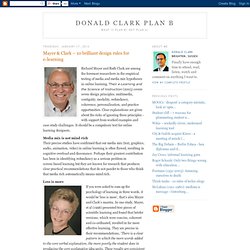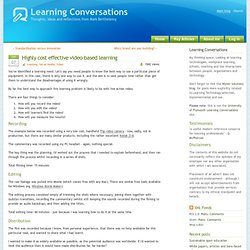

Mlearning. C4LPT. Mayer & Clark – 10 brilliant design rules for e-learning. Richard Mayer and Ruth Clark are among the foremost researchers in the empirical testing of media and media mix hypotheses in online learning.

Their e-Learning and the Science of Instruction (2003) covers seven design principles; multimedia, contiguity, modality, redundancy, coherence, personalisation, and practice opportunities. Clear explanations are given about the risks of ignoring these principles - with support from worked examples and case study challenges. It should be a compulsory text for online learning designers. Media mix is not mind rich Their precise studies have confirmed that our media mix (text, graphics, audio, animation, video) in online learning is often flawed, resulting in cognitive overload and dissonance. Less is more If you were asked to sum up the psychology of learning in three words, it would be ‘less is more’, that’s also Mayer and Clark’s mantra. Avoid eye candy They are critical of gratuitous graphics which are added to simply fill slots on pages of text. Presentation Design & Training. Elearning Resources.
New to Elearning?

Welcome to the party - we've been here a while and know it can be a bit confusing. So we've got a whole section to help get you started, and if you need more help just let us know and we'll see how we can help. Get the low-down on elearning. Social Networks.
eLearning Design. Online teaching. E-Learning. Key Innovation Drivers for Learning Environments. It seems we’re in the midst of a revolution that will dramatically change the way we learn.

In a recent post about Key Innovation Drivers for Learning Environments on his own blog, our CEO, Eric Shepherd, suggests that key goals of these new environments will be to: Use competency maps to understand where learners are and help them navigate to where they want to beMagically expose content at the moment of need and in the right context Inter-system data sharing to allow personalization Eric regards technology as crucial to turning us away from the formal, academic learning model (reliant on hard-to-find content such as books stored in libraries) to learning that is more personalized, accessible and shareable. This change will rely on learning content that is available and discoverable, inter-system data sharing that allows personalization and data flows that keep stakeholders engaged.
There’s a lot more detail in Eric’s post, so click here to read the whole article.. OU researchers' top 10 innovations to transform education in five years.
Online University lectures. Tutorials. Highly cost effective video-based learning. You've identified a learning need.

Let's say you need people to know the best way to use a particular piece of equipment. In this case, there is only one way to use it, and the aim is to save people time rather than get them to understand the disadvantages of using it wrongly. By far the best way to approach this learning problem is likely to be with live action video. There are four things to consider: How will you record the video? Recording The example below was recorded using a very low cost, handheld Flip video camera - now, sadly, not in production, but there are many similar products, including the rather excellent Kodak Zi-8.
The commentary was recorded using my PC headset - again, nothing special. The key thing was the planning. Total filming time: 15 minutes Editing The raw footage was pulled into iMovie (which comes free with any Mac). Total editing time: 60 minutes - just because I was learning how to do it at the same time. Distribution So I popped it on Youtube. Results.